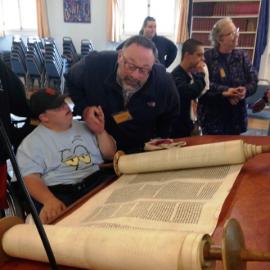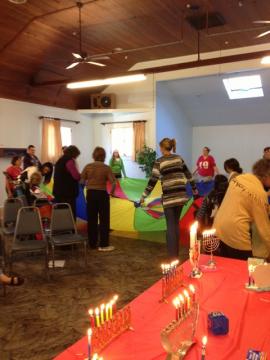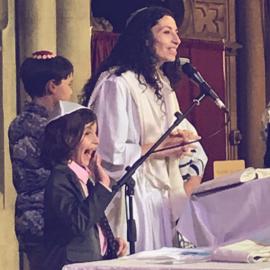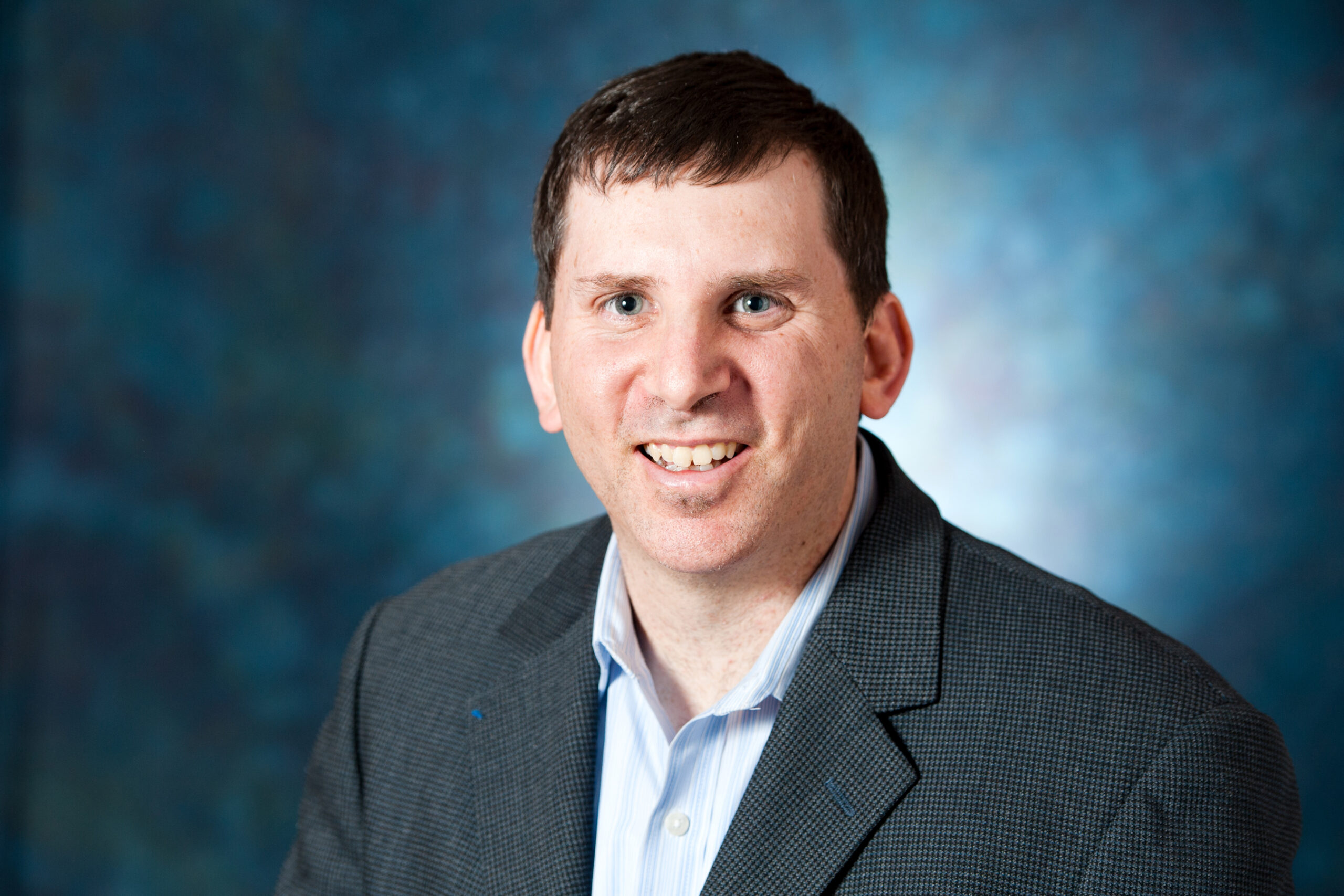
Celebrations program at Ner Shalom
Fifty miles may seem like a long way to attend a synagogue program, especially when other congregations are within easy driving distance. Yet about 10 times a year, Rae Lorvick-Patt—a 21-year-old with physical and cognitive impairments—and her mother make the hour-plus drive from Oakland, Calif., to Congregation Ner Shalom in Cotati. They are far from the only family to regularly trek from the Bay Area to Sonoma County.
Why?
Because Ner Shalom is home to Celebrations, a groundbreaking program serving Jewish children and young adults with substantial disabilities, including Down syndrome, cerebral palsy and autism. There, disabled individuals can access the joy of Jewish ritual and community, learn in a setting tailored for their needs and socialize with peers.
Celebrations events tend to be informal, sensory-appropriate and generally structured around the holidays. The most well-attended annual event is called “Havdalah With the Horses” and takes place at a hippotherapy center, which uses horseback riding as a means of therapeutic treatment. Each gathering includes a parental break, which offers parents rare opportunities to engage in Jewish learning, socialize or just relax.
According to Jennifer Lorvick, one of Rae’s two mothers, if Celebrations didn’t exist, then her daughter wouldn’t experience Judaism in her life.
“Celebrations creates opportunities for people who have been shut out of Jewish experience and ritual. My daughter loves it. She loves the ritualistic aspect of it,” said Lorvick, who is not Jewish but volunteers as the program’s communications coordinator.
“It’s a community of people who have similar experiences that creates a comfort level you just don’t have elsewhere,” continued Lorvick. “Rae, who is extremely shy, is able to smile, talk to people and interact at Ner Shalom. For young people like her, routine is everything. We rarely miss a Celebrations event. We put it on Rae’s calendar, and she really looks forward to it.”

Celebrations program at Ner Shalom
Celebrations is just one example of how Reconstructionist communities across North America are working towards full inclusion of people with disabilities. With a welcoming ethos and a drive to break down barriers, Reconstructionist congregations and havurot have been part of a revolution that’s taken place in the public awareness of the importance of disability inclusion and related services.
“The key to good inclusion is to recognize that you are dealing with a human being who happens to have a disability, rather than a person with a disability who happens to be a human being,” said John Riehl, a Reconstructing Judaism board member and former president of Oseh Shalom in Laurel, Md. He himself is blind.
From the Malibu Jewish Center in California to Dorshei Tzedek in Massachusetts, communities have formed inclusion committees, reviewed the accessibility of physical structures, re-examined religious-school curricula and examined how people are greeted when they enter Shabbat or holiday services. They have done this by tailoring programs that specifically serve the needs of disabled individuals and their families, and by fully integrating individuals into mainstream programs—or some combination of the two.
“It is not only about what communities owe to a person with disabilities. It is about how much people with disabilities can add to the communal experience,” said Rabbi Mordechai Liebling, who directs the Reconstructionist Rabbinical College’s Social Justice Organizing Program.
Liebling’s adult son Lior, who has Down syndrome, was the subject of a 2008 documentary called Praying With Lior. The film chronicles Lior’s preparation for his bar mitzvah at Miskhan Shalom in Philadelphia, exploring his passion for davening. The film has been credited with helping spread awareness of the need for disability inclusion in Jewish settings. (Those interested in screening the film can contact the director, Ilana Trachtman, at prayingwithlior@hotmail.com or through the website, prayingwithlior.com.)
What it means to be fully inclusive
Despite the many gains, nearly everyone connected to the issue acknowledges that much remains to be done. Why is this work so challenging?
For starters, there’s the sheer number of adults and children living with disabilities. One out of every five adults in the United States has some type of disability, according to a 2015 study by the Center for Disease Control and Prevention.
Then there’s the fact that the terms “disability” and “disabled” serve as wide categorical umbrellas that cover an enormous spectrum of people: those with visual and hearing impairments, cognitive disabilities, sensory-issue learning differences, physical handicaps and autism. Many Jewish communities have also begun to include people struggling with various forms of mental illness, which often add further complications because mental illnesses are among the disabilities that can be all but invisible.
There also comes the expense of making buildings fully accessible—expenses that often exceed the means of all but the most-well-endowed communities.
And, of course, it’s difficult to define what it means to be fully inclusive.
“The biggest thing is being open and being prepared to have hard conversations,” said Rabbi Michelle Greenfield, RRC ’12, who for some 15 years has worked with disabled individuals and currently directs the Torah School at Kol Tzedek in Philadelphia. Greenfield also serves as the congregation’s inclusion coordinator and helped launch a well-known special-needs program at Mishkan Shalom. “Communities need flexibility and honesty. If your space is not yet physically accessible, make that clear.”
Gabrielle Kaplan Mayer co-created the Mishkan Shalom Celebration Program, an adaptation of Ner Shalom’s. Mayer also directs Philadelphia’s Whole Community Inclusion Program at the Jewish Learning Venture and is the parent of a teenager with autism. She explained that communication remains a challenge; while the Jewish community is offering an unprecedented number of services across the board, the word still hasn’t gotten out to many of the people who would want to access such programs.
“I have seen a huge cultural shift. Even five years ago, when we started Whole Community Inclusion Program, it was harder to find people to take advantage of the different trainings we offered,” said Kaplan-Mayer, who earned a master’s degree in Jewish studies at the Reconstructionist Rabbinical College.
Seeking to raise the issue of disability inclusion to the highest levels of synagogue life, congregations have created inclusion committees and named point people—volunteer or professional—to serve as initial contacts. According to Shelly Rosenberg, former president of Or Hadash: A Reconstructionist Congregation in Fort Washington, Pa., the formation of a standing inclusion committee led the congregation to discover it wasn’t as welcoming or accessible as many believed. The committee found that the bimah and restrooms were not fully accessible, and has since worked to rectify these issues.
“Having a permanent inclusion committee ensures that inclusion will be part of every discussion at every committee,” said Rosenberg, chair of Or Hadash’s committee. “Don’t think anything happens just by having good intentions.”
It’s impossible for congregations to anticipate every potential needed accommodation, acknowledged Jeff Spitzer-Resnick, president of Congregation Shaarei Shamayim in Madison, Wis., and a noted disability advocate and attorney. “Meeting the needs of individuals with disabilities is so individualized; nobody can predict all the scenarios.”
The congregation rents space on a bus line and ensures that the spaces it pays for are compliant with the Americans for Disability Act. (Religious organizations are not required to be ADA-compliant.) Spitzer-Resnick acknowledged that Shaarei Shamayim has struggled with whether to hold events in members’ homes, which tend to be less accessible. For now, the congregation has decided that it didn’t want to lose the ability to hold more intimate events in private homes, which admittedly can be problematic for certain individuals.
Congregation Dorshei Tzedek in Newton, Mass., also formed an inclusion committee that spent several years delving into all areas of synagogue and communal life. One of the more symbolic yet meaningful gestures the congregation has created includes official guidelines for greeters at High Holiday services and other occasions.
Among the guidelines, greeters are urged to:
- Speak directly to people with a disability, even when they are accompanied by an assistant;
- Use a normal tone and volume;
- Give extra time as needed;
- Understand that many needs are invisible.
According to Susan Nitkin, Dorshei Tzedek’s inclusion chair, greeting is a key point of contact, where spoken words and non-verbal cues can mean the difference between someone feeling welcome or awkward.
“Even those of us who are well-intentioned don’t always know how to act,” acknowledged Nitkin.
At the Malibu Jewish Center, a belief that there should be no divisions between those who are disabled and those who are not has given rise to the “Hand-in-Hand” program. Founded nearly a decade ago, the after-school program “provides young adults with special needs an opportunity to socialize with mainstream peers, learn new skills and have fun.” The program has secure grant funding from sources like the Jewish Federation and the Windsong Trust.
“This is not a special-needs program. This is an all-abilities program,” said Cantor Marcello
Gindlin, a music therapist who co-directs “Hand-in-Hand,” and who goes on to say that “this is more than a program. It is part of our identity. Our community is here to serve the needs of everybody. Our synagogue is special because of its diversity.”
Arguably, Reconstructionist communities have made great strides in reducing barriers to participation in religious schools and bar and bat mitzvah ceremonies, borrowing from cutting-edge techniques developed in special education.
‘Where he felt accepted and valued’
Zachary Newman, 8, is one child who in an earlier era might have been denied the chance to have a Jewish education. He grapples with a host of learning differences (classified as non-verbal learning disability) and attends a specialized private school on New York’s Upper West Side.

Zachary on the bimah of West End Synagogue
“Despite these challenges, it was important to me, as his mother, that he have a robust Jewish education, learn to read Hebrew and eventually celebrate a bar mitzvah,” said Sara Newman, who is a licensed doula and previously worked in political communications. “I didn’t want him to quit Hebrew school the day after his bar mitzvah, like his father and I both did, because we wanted a community where he felt accepted and valued.”
The family eventually found their way to West End Synagogue, where Rabbi Nadia Gold bonded with Zachary in a Saturday-afternoon program called “Kef Kids,” in which participants learned about the history and mythology of the Jewish people. Whereas in other congregations, it was looked down upon if he spoke out of turn or asked a question deemed inappropriate, there he was embraced. Despite his success, transitioning to Hebrew school proved a bigger challenge.
“The combination of Hebrew and English overwhelmed our child’s brain,” said Newman. “The strategies he used to overcome his learning issues didn’t work in Hebrew, and his English reading skills began to suffer. He cried on Tuesday mornings because he was scared to go Hebrew school in the afternoons.”
Zachary recalled that one breakthrough happened while he was sitting in the rabbi’s office and became fixated on a Post-It ball—a 12-sided, multicolored sticky note repository.
“I thought the books were boring,” said Zachary. “I was looking at the Post-It ball and said that actually [looked] like fun. I can do this in Hebrew. Now, I write the words on the Post-It ball and match Hebrew to English.”
Don’t get him wrong. He’d still rather be playing Minecraft than going to Hebrew school. But he certainly no longer dreads the experience.
The rabbi attributed the school’s success with Zachary to two factors: She first asked him how he might best learn, and the school itself had the staff to offer individualized attention.
“He really needed a one-on-one approach,” said Gold. “He worked one-on-one some of the time; he worked the rest of the time with the rest of the class. We didn’t want to separate him, but we did need to do so a little bit. I’ve worked with special-needs kids, and I come to it with an open mind and a flexibility. You need to be flexible.”
Sara Newman is beyond grateful for that flexibility—and for the chance for her son to thrive.
“The best part? Rabbi Nadia and her teachers worked with our child,” noted Newman. “They saw him as a person and discussed with him what would help him be successful.”








